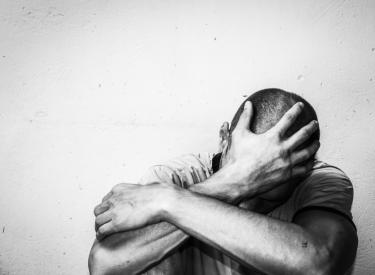
The Truth About Interventions
Trevor Shevin went from being a Wall Street MBA to an in-demand interventionist with impressive success rates. He talks us through what an intervention really is, how it can benefit the entire family, and how an intervention can be an effective gateway to treatment (and he should know: Trevor’s in recovery himself).
What’s the biggest misconception out there about interventions?
Personally, I don’t even really like the word “intervention,” because of the association with what you see on TV.
Interventions are often portrayed in pop culture as very dramatic and scary, but that’s not true in my experience. Interventions are of course difficult, but a good interventionist is there to calm the storm and help navigate a family through it. Ideally, it’s a loving, calm, even peaceful experience.
What’s the goal of an intervention?
The primary purpose of an intervention is to get someone with a substance use disorder the help they need, before it’s too late. We want to prevent the identified patient from going through all the consequences that often times people who are left untreated experience: most notably, overdosing or winding up in jail.
When someone has a substance use disorder, that means they continue to use drugs or drink despite experiencing negative consequences. And sometimes people are in denial—they sort of self-manipulate what’s going on. But other times, their addiction is so strong that the pain of not using is, in their mind, worse than whatever the consequences of their using might be.
At an intervention, we want to give the patient the clarity to make that change in their life, and actually start living in the solution: getting help. What we’re trying to do with an intervention is bring them out of the denial or contemplation stages, and into the action stage, which is seeking treatment.
How does an intervention affect the whole family?
For family interventions, I’m not just intervening on the patient—I’m actually intervening on the entire family. Addiction is called a family disease for a reason. It’s not just because there’s the genetic predisposition, but also because one person’s addiction causes a ripple effect that goes through the whole family that can lead to codependency, a need to set boundaries, a need to have a plan and structure. It’s traumatic for any family member to have a loved one in the throes of addiction. So not only does intervention take a look at the identified patient, but it also looks at the whole family dynamic and addresses all members of the family, and when warranted, provides them with help for themselves as well. It’s not like the addicted person goes away to treatment and it’s just like, “if that person gets better, we’ll all be better.” There’s an aftermath, there’s trauma, there’s PTSD for the entire family that needs to be addressed.
Do you need “tough love” at an intervention?
I don’t believe in shaming or blaming, period. I think that’s very ineffective. You’ll never intellectualize or rationalize someone into treatment.
I’ll self-disclose: I’m in recovery myself. As a person in recovery, I like to hang my hat on this: the average person who struggles with SUD has a higher IQ than someone who doesn’t. For us, SUD is more about our inability to process life through our emotions like a “normal person,” so we look to self-medicate. We can be very sensitive, there can be self-esteem issues, co-occurring issues like depression and anxiety, almost always trauma to some degree, you name it. So, you want to take a look at things from a clinical mental health perspective while also considering the addiction disorder. So I don’t believe in shaming or blaming, all it does is exacerbate the problem.
What I like to do is: I want to orchestrate a family meeting, close friends, people of influence in their life, people they respect, really looking to go for their heart.
What happens at an intervention? Is there a schedule or a plan?
Well, interventions are like weddings: We can plan them as much as we want, but they never go exactly as planned.
But we do plan. I always do a rehearsal, usually the evening before, where I run through the intervention with the people who’ll be attending. Usually when I show up, I see family members and friends with their shoulders up by their ears, they’re so stressed, and by the end of it everyone’s really relaxed, we’re bonded as a group, and we feel confident and united and on the same page.
An effective interventionist creates scenarios where you really reach someone at their heart to give them a moment of clarity. So what we’re looking to do first, in a clinical way, is we want to reach the patient’s heart.
When a patient arrives at an intervention, they’re often thinking they’re going to hear, “What’s the matter with you? How could you do this to us?” And that’s the last thing we want to do. They have enough shame to last them for three lifetimes—we don’t need to add on more. We want to initiate, almost like a love letter at the beginning. You tell the patient all the things you love about them, even if you have to go back and think of times when they were much younger. Really what you’re trying to do is disarm them from feeling attacked, and remind them of who they really are, which they may have lost sight of over the years.
The next part is tricky: After you go through all the things you love about the patient, you transition into saying something like, “however, things haven’t been the same for quite some time.” This is tricky because sometimes there’s an impulse for families to want to vent here. They’re very frustrated, they don’t understand addiction maybe—they don’t know that, really, their loved one’s brain has been kidnapped. And that can make people eager to vent or express anger. So we have to stay away from that, and stick to stating things that you’re seeing and observing. Using “how it makes me feel” language to express yourself. A good example: “When you drive drunk, it terrifies me. The thought of you getting hurt, or hurting someone else, or winding up in jail makes me so sad.”
In an addicted person’s mind, they’re thinking, “my addiction is my problem, leave me alone, I’ll deal with it.” They need to understand there really is a ripple effect in the whole family, and this isn’t actually just about them.
Then, the last part is the ask: “Will you accept the help we’re offering you today?” This is when I’ll do my piece with them and ideally get them to a point where they’re willing to go to treatment. And the vast majority of people do go. But sometimes, the patient digs their heels in. They say, “I hear you, I love you, but no, I’m not going.” You have to be prepared for this potential outcome. So I ask every family to prepare a bottom line or consequence letter, saying something like, “just like you have the right to choose not to get help, I have the right to [X].” You’re looking for leverage, to no longer enable the patient’s disease. So either emotional or sometimes financial leverage is good, but nothing punitive for the sake of being punitive. Again, we don’t want to punish someone who’s suffering, we just want to preclude them from continuing on in their addiction.
Most of the time we don’t even have to use that second letter, but if we do, it’s setting up boundaries for moving forward. And it cannot be a bluff, because once that’s breached, you’re back to where you were before the intervention.
How many people typically attend an intervention? Who should be there, and who shouldn’t?
The average is 4-8 people. Sometimes it’s less, sometimes there’s more. More than that can get a little oversaturated, and you can lose the message.
Basically, you’re looking for people whom the patient respects. Family members, close friends, a beloved teacher or coach for younger patients. It can also be great to have to have a multi-generational group: grandparents, adult children.
You don’t want their “partners in crime” there. That would be friends, family members or coworkers who enable them. You have to be very careful not to invite someone who could be harmful to the patient: someone who’ll instigate shaming and blaming, or even someone who could adversely affect their career. An experienced interventionist will work with you to determine exactly who should be there.
Are interventions typically successful?
My goal at an intervention is to get that person into in-patient treatment. My track record is, 85% of the time, they go that day.
Of the remaining 15%, half of them go within a week of the intervention. That second letter we talked about earlier, the one that reinforces boundaries, really helps.
A good interventionist stays engaged all the way through this process. Even if the person goes to treatment, a good interventionist helps build and implement an aftercare plan. There’s a high rate of relapse—over 70% of people coming out of treatment relapse within that first year. The point of intervention is not only to get someone into treatment, but to make sure it’s full circle and they’re set up to succeed when they leave treatment.
And as for interventions where you don’t get the person into treatment, I think those can still be successful in a way, because there’s still going to be a major change in the family dynamic and in the person’s life. It helps restructure the family to no longer potentially enable what’s going on.
Would you say an intervention is always necessary?
To determine if we need to do an intervention, I usually ask the family: What are the consequences that this person is experiencing due to their substance use, whether they realize them or not? Consequences come in two categories: One is tangible consequences, like a DUI, loss of job, loss of a relationship, physical health issues. But there are also the intangible consequences, which are related to mental health, alienating loved ones—when you see someone who should be thriving in life, but they’re just not happy.
It’s very rare that someone calls me and there’s not something going on that needs to be addressed somehow, whether it's through an intervention or not. A good interventionist can help you determine if an intervention is necessary or if it’s time for one.
What happens when someone refuses help? Have you ever had experiences where people become angry?
I don’t want to sound like I’m self-promoting, but I’m really good at deescalating potential difficult situations. I can’t speak for all interventionists, but I do think that de-escalation skills are critical.
Even for that 15% of people who don’t go to treatment right away, I almost always get a handshake or a hug once the intervention is done. And I follow up with them from there. We all exchange phone numbers, and I stay engaged and follow through, so that eventually we can get the person into the situation where they’re getting the help they need, even if it has to come later.
So for me, no, angry stuff never goes on. I’ve never had an attack, I’ve never had anyone get violent with me. Once an intervention starts, I’ve never even had anyone who turns around and leaves. They can be difficult of course, but it’s always a calm experience for the family and the person themselves.
What are the immediate next steps after intervention?
For the majority of patients, they head off to treatment, and from there we set up an aftercare plan and I stay involved to help implement it with the family.
Immediately following an intervention where a person elects not to go to treatment, I always do a debriefing session with everyone who’s there. So we regroup, we go through, I recount what occurred, what my take-always were, what I saw, and we develop a plan on how to move forward collectively.
For about 7%, they don’t go to treatment that day, but they end up going within a week because we’ve been enforcing the boundaries we’ve set.
So after every intervention, regardless of the immediate outcome, it’s all about keeping up contact, maintaining boundaries, and continuing to work to get the person the help they need.
If a family wants to seek the help of an interventionist, what should they look for in that person?
First and foremost, the interventionist should have a CIP credential. That stands for Certified Interventionist Professional.
I think it’s great to get a referral from someone you trust. A therapist, a clinician, a treatment center, or even a friend who’s worked with an interventionist before. It’s good to have someone who can vouch for the interventionist.
After that, I recommend picking up the phone and talking to them. Talk to a few CIPs. If you feel comfortable with the person, you get the sense they know what they’re talking about, they’re a good listener, they’re open minded, they’re client-centric, those are great signs that the CIP could be the right fit for you. Making sure it’s someone with whom you feel comfortable and safe is very important.
For me, I got into this because I love helping people. Going from working on Wall Street to doing this sort of work, it’s quite the transition. And it’s a beautiful thing. I still get letters and emails and calls from families I’ve worked with. I find the work incredibly fulfilling, and I think that’s important for a good interventionist.



